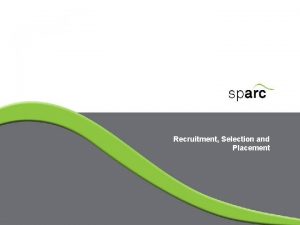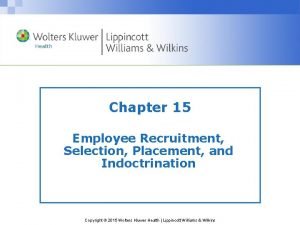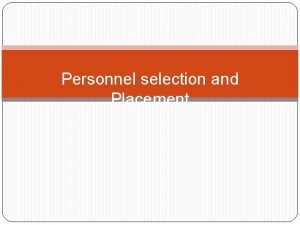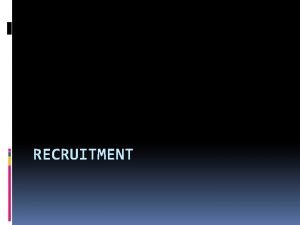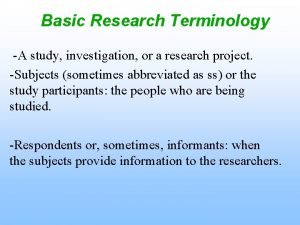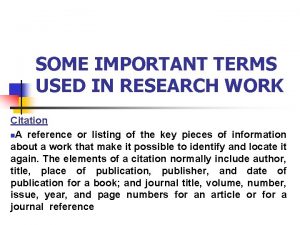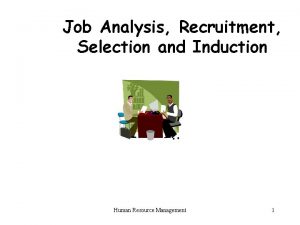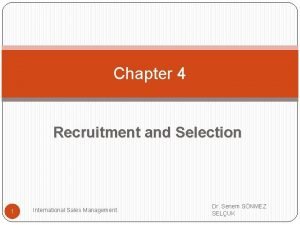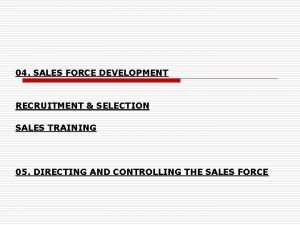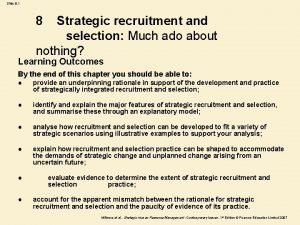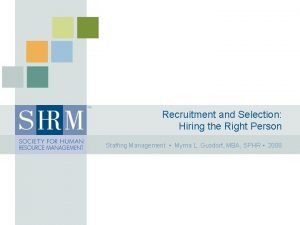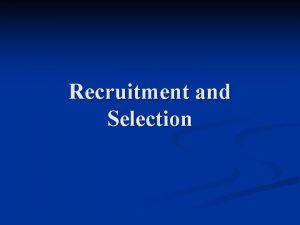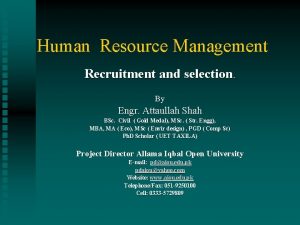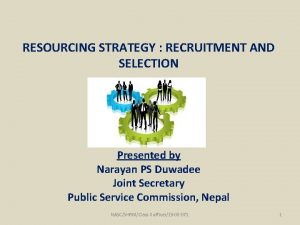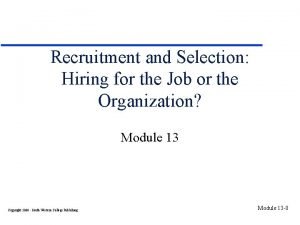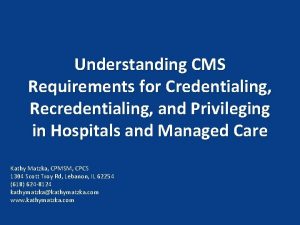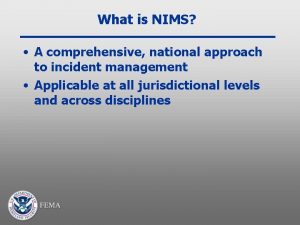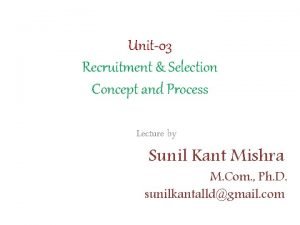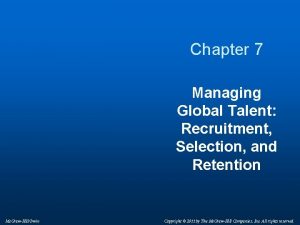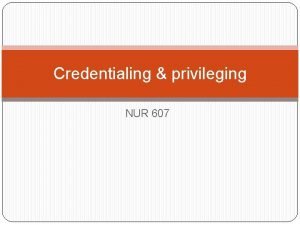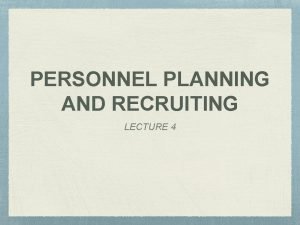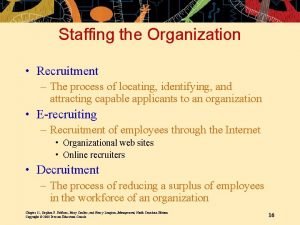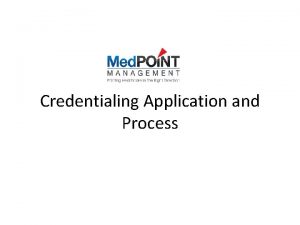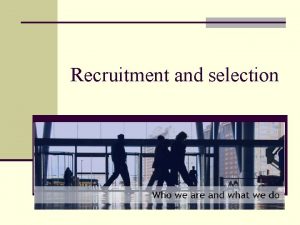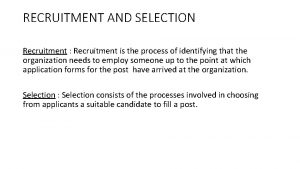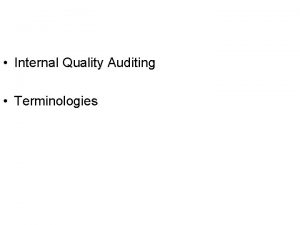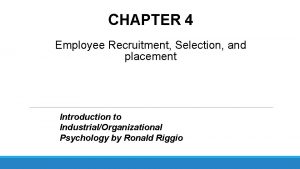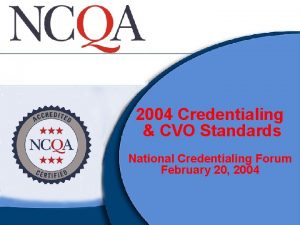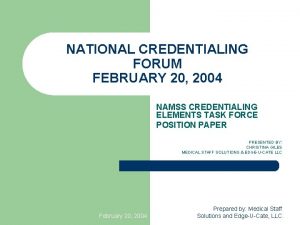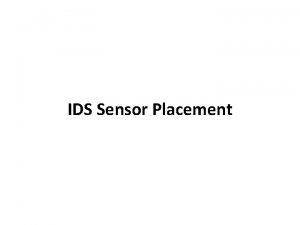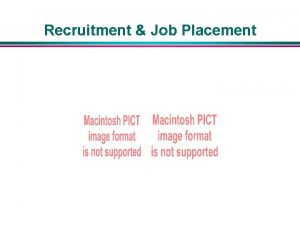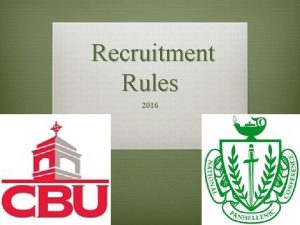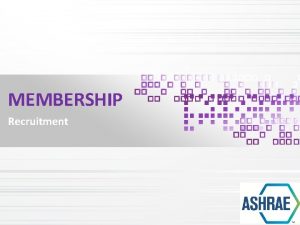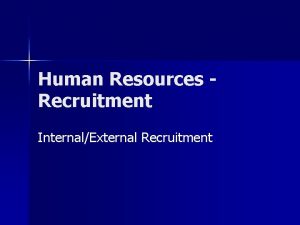RECRUITMENT CREDENTIALING SELECTION PLACEMENT AND PROMOTION INTRODUCTION TERMINOLOGIES


























































- Slides: 58

RECRUITMENT: CREDENTIALING, SELECTION, PLACEMENT AND PROMOTION

INTRODUCTION

TERMINOLOGIES RECRUITMENT SELECTION ADMINISTRATION ADMISSION DISCIPLINE

RECRUITMENT Recruitment is an important function of health manpower management, which determines, whether the required will be available at the work spot, when a job is actually to be undertaken.

MEANING In a simple term, recruitment is understood as the process of searching for and obtaining applicants for job, among which the right people can be selected.

DEFINITION 1. According to IGNOU Module: “It is a process in which the right person for the right post is procured”. 2. According to Yoder: “Recruitment is a process to discover the sources of manpower to meet the requirements of the staffing schedule and to employ effective measures for attracting that manpower in adequate numbers to facilitate effective selection of an efficient working force. ”

TYPES OF RECRUITMENT 1. PLANNED 2. ANTICIPATED 3. UNEXPECTED

LIKAGES OF RECRUITMENT TO HUMAN RESOURCE ACQUISITION

BASIC ELEMENTS OF SOUND RECRUITMENT POLICY Use of the attractive recruitment literature and publicity Use of the scientific tests for determining abilities of the candidate Tapping capable candidates from within the services Placement program which assigns the right man to the right job. A follow up probationally program as an integral process.

PURPOSES AND IMPORTANCE Determine the present and future requirements of the organization in conjunction with the personnel planning and job analysis activities Increase the pool of job candidates with minimum cost Help increase the success rate of the selection process reducing the number of obviously under qualified or over qualified job applicants. Meet the organization’s legal and social obligations regarding the composition of its work force

Start identifying and preparing potential job applicants who will be appropriate candidates Increase organizational and individual effectiveness in the short and long term. Evaluate the effectiveness of various recruiting techniques and sources for all types of job applicants.

OBJECTIVES OF RECRUITMENT To attract people with multi-dimensional skills and experiences that suit the present and future organizational strategies To induct outsiders with new perspective to lead the company To infuse fresh blood at all levels of organization To develop an organizational culture that attracts competent people to the company To search or heat hunt/ head pouch people whose skills fit the company’s values To devise methodologies for assessing psychological traits

To search for talent globally and not just within the company To design entry pay that competes on quality but not on quantum To anticipate and find people for positions that does not exist yet.

PRINCIPLES OF RECRUITMENT Termination and creation of any post should be done by responsible officers. Only the vacant positions should be filled and neither less nor more should be employed. Job description/ work analysis should be made before recruitment. Procedure for recruitment should be developed by an experienced person

Recruitment of workers should be done from internal and external sources Recruitment should be done on the basis of definite qualifications and set standards. A recruitment policy should be followed Chances of promotion should be clearly stated Policy should be clear and changeable according to the need.

SOURCES OF RECRUITMENT I. INTERNAL SOURCES II. EXTERNAL SOURCES

INTERNAL SOURCES Former employees Employees referrals Present employees Previous applicants

EVALUATION OF INTERNAL RECRUITMENT: ADVANTAGES: It is less costly Organizations typically have a better knowledge of the internal candidates skills and abilities. An organizational policy of promoting from within can enhance employees’ morale, organizational commitment and job satisfaction.

DISADVANTAGES Creative problem solving may be hindered by the lack of new talents. Divisions Politics compete for the same people probably has a greater impact on internal recruiting and selection than does external recruiting.

II) EXTERNAL SOURCES PROFESSIONAL OR TRADE ADVERTISEMENTS EMPLOYMENT EXCHANGE CAMPUS RECRUITMENT CONSULTANTS RADIO N TELEVISION WALK-IN, WRITE-IN, TALK-IN

MODERN SOURCES OF RECRUITMENT CONSULT-IN TELE RECRUITMENT WALK-IN MODERN SOURCES

RECRUITMENT PROCESS / STEPS 3. SEARCHING 2. STRATEGY PLANNING 1. PLANNING 4. SCREENING STEPS 5. EVALUATION N CONTROL

FACTORS AFFECTING RECRUITMENT The size of the organization The employment conditions in the community where the organization is located The effects of past recruiting efforts which show the organization’s ability to locate and keep good performing people Working conditions, salary and benefit packages offered by the organization- which may influence turnover and necessitate future recruiting The rate of growth of organization The level of seasonality of operations and future expansion and production programs. Culture, economical and legal factors etc.

CREDENTIALING

INTRODUCTION

DEFINITION 1) Credentialing is the process by which selected professionals are granted privileges to practice within an organization. In health care organizations this process has been largely confined to physicians. Limited privileges have been granted to psychologists, social workers and selected categories of nurses, such as nurse anesthetists, surgical nurses, and midwifes. Russell C Swan’s burg

PURPOSE OF CREDENTIALING To prevent a problem before it happens. To research the qualifications and backgrounds of individuals and companies. Credentialing is also the process of reviewing and verifying information.

SIGNIFIANCE CREDENTIALING IS VERY SIGNIFICANT BECAUSE IT SHOWS THAT AN INDIVIDUAL OR COMPANY’S PERFORMING A SERVICE IS QUALIFIED TO DO SO.

LEGAL PROTECTION IT IS A GOOD IDEA TO HAVE CREDENTIALING PROCESS TO PROTECT YOU AND YOUR BUSINESS FROM A LAWSUIT OR OTHER LEGAL PROBLEMS.

PROFESSION

HEALTH CARE CREDENTIALING DEFINITION: Health care credentialing is a system used by various organizations and agencies to ensure that their health care practitioners meet all the necessary requirements and are appropriately qualified. The credentials may vary depending on the specified area of the practitioner.

WHO IS CREDENTIALED?

COMPONENTS OF CREDENTIALING 1. APPOINTMENT 2. CLINICAL PRIVILEGES 3. PERIODIC REAPPRAISAL

CRITERIA FOR APPOINTMENTS WOULD INCLUDE PROOF OF LICENSURE, EDUCATION AND TRAINING, SPECIALITY BOARD CERTIFICATION, PREVIOUS EXPERIENCE, AND RECOMMENDATIONS.

PRINCIPLES OF CREDENTIALING ACCORDING TO (ANA) 1) Those credentialed. 2) Legitimate interests of involved occupation, institution, and general public. 3) Accountability 4) A system of checks and balances 5) Periodic assessments 6) Objective standards and criteria and persons competent in their use 7) Representation of the community of the interests

8) Professional identity and responsibility 9) An effective system of role delineation 10) An effective system of program identification 11) Coordination of credentialing mechanisms 12) Geographic mobility 13) Definitions and terminology 14) Communications and understanding.

SELECTION

INTRODUCTION

DEFINITION “It is the process of choosing from among applicants the best qualified individuals, Selecting includes interviewing, the employer’s offer, acceptance by the applicant, and signing of a contract or written offer”. Selection may be carried out centrally or locally, but in either case certain policies or methods are adopted

SELECTION POLICIES 1. Application forms 2. Selection committee 3. Orientation program 4. Development of master plan 5. Parent teachers association

STEPS IN SELECTION INTERVIEW BY PERSONNEL DEPT PRE EMPLOYMENT TEST INTERVIEW BY DEPARTMENTAL HEAD DECISION OF THE ADMINISTRATOR TO ACCEPT OR REJECT MEDICAL EXAMINATION CHECK OF REFERENCES ISSUE OF APPOINTMENT LETTER

PLACEMENT

INTRODUCTION

DEFINITION State of being placed or arranged

IMPORTANCE OF SELECTION AND PLACEMENT To employee qualified and competent hands that can meet the job requirement of the organization To place job applicants in the best interests of the organization and the individual To help in human resources man power planning purposes in organization To reduce recruitment cost that may arise as a result of poor selection & placement exercises.


INTRODUCTION

DEFINITION A change for better prospects from one job to another job is deemed by the employee as a promotion”.

FACTORS IMPLYING PROMOTION 1. AN INCREASE IN SALARY 5. A BETTER FUTURE 2. AN INCREASE IN PRESTIGE FACTORS 4. ADDITIONAL SUPERVISORY RESPONSIBILITY 3. AN UPWARD MOVEMENT IN THE HIERARCHY OF JOBS

NATURE AND SCOPE OF PROMOTION Seniority versus merits:

PROMOTION POLICY Charts and diagram showing job relationships and ladder of promotion should be prepared. There should be some definite system All vacancies in the organization should be notified The final approval should be from top most management authorities All promotion should be for a trail period

ADVANTAGES OF A SOUND PROMOTION POLICY It provides an incentive to employee to work more and show interest in their work. It develops loyalty amongst the employees, because a sound promotion policy assures them of their promotions if they are found fit. It increases satisfaction among the employees. It generates greater motivation as they do not have to depend on mere seniority for that advancement.

A sound promotion policy retains competent employees, and provides them ample opportunities to rise further It generally results in increased productivity as promotion will be based on an evaluation of the employee’s performance. Finally, increases the effectiveness of an organization

SOLUTION TO PROMOTION PROBLEMS In promoting an employee to a better job, his salary should be at least one step above his present salary. Specific job specifications will enable an employee to realize whether or not his qualifications are equal to those called for. There should be a well-defined plan for informing prospective employees may know the various avenues for their promotion. The organization chart and promotion charts should be made so that employees may know the various avenues for their promotion.

The promotion policy should be made known to each and every organization. Management should prepare and practice promotion policy sincerely.

CONCLUSION

JOURNAL ABSTRACT BIBLIOGRAPHY B T Basavanthappa. Nursing Administration. 2 nd ed New Delhi: Jaypee brothers ; 2009. Dr. S. L. Goel. Dr. R. Kumar. Hospital administration and management theory and practice. 1 st ed New Delhi: Deep & Deep publications; 2007 AG Chandorkar. Hospital Administration and planning. 2 nd ed. New Delhi: Paras medical publishers; 2009. Patricia S. Yodar. Leading and managing in nursing wise. 3 rd ed St. Louis Missouri: Mosby; 1999 Linda Roussel. Management and leadership for nurse administrators. 4 th ed Boston: Jones and Bartlett publishers; 2006

THANK YOU
 Recruitment and selection course outline
Recruitment and selection course outline The new recruit chapter 15
The new recruit chapter 15 Placement in selection process
Placement in selection process Centralized recruitment
Centralized recruitment Manned exhibits meaning
Manned exhibits meaning Itsm terms and terminologies
Itsm terms and terminologies Security terminologies and principle
Security terminologies and principle Regulation of recruitment and placement activities
Regulation of recruitment and placement activities Recruitment and induction process
Recruitment and induction process Ethical hacking terminologies
Ethical hacking terminologies Basic research terms
Basic research terms Define dominant trait
Define dominant trait Three authors citation
Three authors citation Staffing process
Staffing process Sprylogic technologies ltd.
Sprylogic technologies ltd. What is meant by the term recruitment
What is meant by the term recruitment Job analysis recruitment and selection
Job analysis recruitment and selection Exam questions on human resource development
Exam questions on human resource development Recruitment and selection of sales personnel
Recruitment and selection of sales personnel Sales force selection process
Sales force selection process Strategic recruitment and selection
Strategic recruitment and selection Recruitment and selection: hiring the right person
Recruitment and selection: hiring the right person Definition of recruitment and selection
Definition of recruitment and selection Trends in recruitment and selection
Trends in recruitment and selection Recruitment and selection in human resource management
Recruitment and selection in human resource management Recruitment and selection definition
Recruitment and selection definition Factors influencing recruitment and selection
Factors influencing recruitment and selection Recruitment and selection process flowchart
Recruitment and selection process flowchart Differentiate between recruitment and selection.
Differentiate between recruitment and selection. Cms credentialing and privileging
Cms credentialing and privileging What is nims
What is nims Place promotion
Place promotion Selection placement
Selection placement Selection and placement
Selection and placement Recruitment & selection process
Recruitment & selection process Global recruitment selection
Global recruitment selection Acp credentialing
Acp credentialing Nacp credentialing
Nacp credentialing Mtm credentialing
Mtm credentialing Namss credentialing 101
Namss credentialing 101 Credentialing resource center
Credentialing resource center Two way selection and multiway selection in c
Two way selection and multiway selection in c Multiway selection
Multiway selection Procedure of pure line selection
Procedure of pure line selection Balancing selection vs stabilizing selection
Balancing selection vs stabilizing selection Similarities
Similarities K selected
K selected Natural selection vs artificial selection
Natural selection vs artificial selection Artificial selection vs natural selection
Artificial selection vs natural selection Disruptive selevtion
Disruptive selevtion Logistic model of population growth
Logistic model of population growth Natural selection vs artificial selection
Natural selection vs artificial selection Product marketing
Product marketing Northern and rural recruitment and retention initiative
Northern and rural recruitment and retention initiative Expanding the talent pool recruitment and careers
Expanding the talent pool recruitment and careers Pool germany
Pool germany Building a recruitment and retention plan
Building a recruitment and retention plan Planning personnel
Planning personnel Recruitment is the process of locating identifying and
Recruitment is the process of locating identifying and
